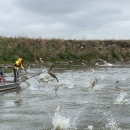Species that are considered high risk have a well-documented history of invasiveness in at least one location globally, and a high or medium climate match to the contiguous United States.
Rhinella marina is a South American toad that has been introduced to and established in many countries in the Pacific and the Caribbean, primarily as biological control for crop pests. The species lays its eggs in fresh water. R. marina is omnivorous to the extreme and carries a toxin that can be fatal to potential predators, reducing their populations and sometimes indirectly facilitating prey populations as a result. R. marina influences the behavior of native anurans and can displace these species. Some research even indicates rapid directional selection on traits of native species as a result of R. marina invasion. R. marina is susceptible to two OIE-reportable diseases. Climate match for the contiguous U.S. is high, with highest climate match in Florida (where the species is already established) and southern Texas (where the species is native). Overall risk posed by this species is high.



